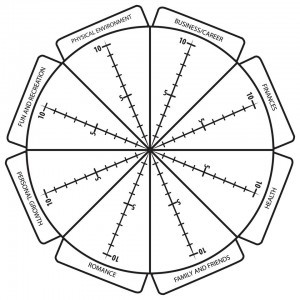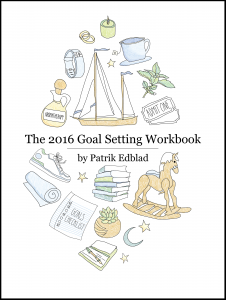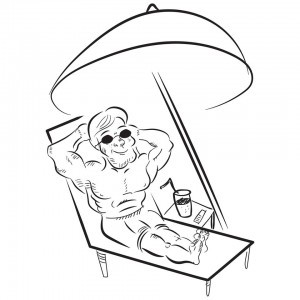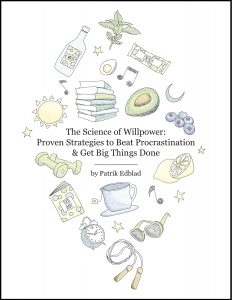Patrik Edblad's Blog, page 22
March 8, 2016
How to Deal With Pain: First & Second Darts
Last week I wrote about the Buddhist idea of The Two Minds, and how knowing the difference between your thinking mind and your observing mind is the first step in effectively dealing with emotional problems.
Since a lot of readers wrote back to me saying how helpful that article was, today I thought I’d to share a related Buddhist idea that I’ve found extremely helpful in my life. This concept is known as:
First & Second Darts
Physical and psychological pain are inevitable parts of life. It’s just the way we humans are designed. To survive physically, we need our body to let us know when it’s ill or injured. To work psychologically and socially, we need minds that send different signals of distress such as loneliness, anger, fear, rejection, threat and grief.
Losing these physical and psychological signals of pain is in fact very dangerous. We need to know that we’ve accidentally put our hand on the stove to do something about it. Or feel guilty when we’ve mistreated someone else. Pain is what lets us know.
In Buddhism, these unavoidable pains in life are known as ‘first darts.’ These are the darts life throws at us that we can’t do anything about.
But what we can do, is avoid throwing ‘second darts‘ at ourselves. These second darts are our judgments and reactions to the first darts.
For example, let’s say you get a sudden headache. This is the first dart. The second darts come in the form of your thoughts about the situation: ‘Why does this always happen to me?!’, ‘This headache is driving me crazy!!’, ‘I hate this pain!’ and so on.
Each time you buy into these thoughts you make the experience of the headache even worse. You’re putting logs on the fire. Now, it’s not just the pain from the first dart you’re experiencing; you’re also hitting yourself with a bunch of second darts that are causing you to suffer.
“Pain is Inevitable. Suffering is Optional.”
This Buddhist proverb simply and brilliantly sums up how this works. Pain is the first darts. Suffering is the second darts.
You’re always going to have to deal with pain because that’s how humans function in the world.
But whether or not you’ll SUFFER from that pain is completely up to you:
“It’s not what happens to you, but how you react to it that matters.” – Epictetus
In my experience, I’ve found this to be very true. Over the last couple of months, I’ve had to deal with a persistent feeling of a lump in the throat (the clinical term is Globus sensation). This lump used to drive me crazy but over the last couple of weeks, I’ve tried keeping this idea of first and second darts in mind.
The Globus sensation is the first dart. My judgments about it make up the second darts. The more I’ve managed to be mindful of the lump in my throat without getting caught up in negative thoughts and feelings about it, the less I’ve suffered from it.
Pain x Resistance = Suffering
The next time you’re experiencing pain, keep this simple equation in mind. Experience the first dart without resisting it since this will only cause suffering. This is another aspect of life where mindfulness is extremely helpful:
Simply hold the painful sensation or emotion in present awareness. Imagine your mind as a clear blue sky. Know that the pain will pass through it like a storm cloud, never tainting or harming the mind itself.
Next, look for second darts. Pay attention to the thoughts and feelings your thinking mind is adding to the already painful experience. Try to disidentify from these as well. Remember that you are not your thoughts and do not buy into them.
Let the first dart do its thing without judging or resisting it. The more you practice this, the less unnecessary suffering you’ll have to deal with.
“I’ve lived through some terrible things in my life, some of which actually happened.” – Mark Twain
Footnotes
I learned about the concept of first and second darts in Rick Hanson’s awesome book Buddha’s Brain: The Practical Neuroscience of Happiness, Love, and Wisdom.
The post How to Deal With Pain: First & Second Darts appeared first on Selfication.
March 1, 2016
How to Deal With Emotional Problems: Getting to Know Your Two Minds
Imagine it’s early in the morning. You get out of bed, walk to the window and pull the curtains to the side. The sun is up and there’s not a cloud in sight.
You think to yourself “Wow, look at that. It’s going to be a beautiful day today.”
Now, have you ever asked yourself this: If your mind is saying it’s a beautiful day, then who is the one listening to this statement?
Isn’t this strange? I mean, you already knew it’s a beautiful day the second you looked out the window. So why is your mind repeating this already obvious fact? And who is it talking to?
The Two Minds
In Zen, they explain this weird phenomenon by referring the two minds — the thinking mind and the observing mind. This is a common concept in Buddhism and contemporary western therapies like Acceptance-Commitment Therapy, or ACT for short, are beginning to catch on to how helpful it can be to solve a lot of our day to day emotional problems.
You see, the problem with the thinking mind is that we don’t have complete control over it. A very quick thought experiment can prove this point:
For the next ten seconds, DO NOT THINK OF A WHITE BEAR.
If you’re like most people, that bear will be haunting you like crazy, especially if you try hard to suppress it (1).
You’ve probably noticed that the thinking mind is always blabbing away. While you’re waiting in line, when you’re in an important meeting, when you’re trying to go to sleep, when you ‘tune out’ in a conversation with someone else and, if you’re a writer like me, it seems to be especially active when you’re trying to crank out your words for the day.
As a matter of fact, I’ve had tons of thoughts popping up while writing this: ‘Are you sure this is relevant?’, ‘Wow, you really butchered that sentence,’ ‘Nobody is going to want to read this,’ ‘Are you getting WORSE at English every day?’ and a whole slew of other, quite unhelpful, comments.
This running commentary in our heads is the thinking mind in action.
The same is also true for emotions. And that is actually where most of our suffering come from — not from the negative emotions themselves, but from helplessly getting sucked into them.
The Thinking Mind & The Observing Mind
So, why is all this important? Well, because most of our negative psychological and emotional experiences happen because we can’t differentiate between out thinking mind and our observing mind.
Most people want to ‘get rid’ of their thoughts and feelings. They don’t want to feel stressed, lonely, fearful, angry, jealous or nervous. That’s fair enough.
But the thing is you can’t control your thoughts and emotions. Why? Because they belong to your thinking mind. Thoughts and feelings have always popped up throughout your life, and they will continue to do so.
What you CAN do is change the way you relate to these feelings and thoughts. Realize that you’re experiencing your thoughts and emotions through your observing mind and avoid identifying with your thinking mind.
Instead of saying ‘I am angry,’ say ‘I feel anger.’ Instead of saying, ‘I am nervous,’ say, ‘I feel nervousness.’ Instead of saying, ‘I am jealous,’ say, ‘I feel jealousy.’
This might seem like a subtle shift, and it is. Still, it can make a HUGE difference in how you deal with your thoughts and feelings. This is because it creates a separateness between your thinking and observing mind. And this, in turn, helps you to stop identifying with your thoughts and feelings.
When you stop saying ‘I AM angry’ and instead realize that all that is happening is that you are just FEELING anger at this moment, you can start relating to the emotion in a different way.
Instead of perceiving the anger as a part of you, it becomes something fleeting that you can observe without getting caught up in it. As meditation teachers like to put it, your thoughts and feelings become like clouds that pass across the sky.
So, the key to dealing with emotional problems is to always accept what’s going on in your mind. Welcome your thoughts and feelings no matter how scary, uncomfortable or annoying they may be:
This being human is a guest house.
Every morning a new arrival.
A joy, a depression, a meanness,
Some momentary awareness comes
as an unexpected visitor.
Welcome and entertain them all!…
The dark thought, the shame, the malice,
meet them at the door laughing,
and invite them in.
Be grateful for whoever comes,
because each has been sent
as a guide from beyond.
—Rumi
How to Deal With Emotional Problems
Most people deal with their emotional problems by resisting, repressing and ignoring them. In these times of constant distraction, there is no shortage of other things you can turn your attention to when your mind is feeling uneasy.
One recent study showed that most people would rather receive a small electric shock than be alone with their thoughts (2). I suggest we take a more healthy approach to deal with uncomfortable thoughts and feelings:
Become aware of particularly strong thoughts and feelings. Practice catching them as they show up and immediately disidentify with them. Remind yourself that you are not your thoughts.
Use labeling. Research has shown that naming and assessing an emotion transforms the emotion into an object of scrutiny and thereby decreases its intensity (3). So if you’re feeling angry, simply tell yourself: ‘Ah, that’s anger!’ and you’ll most likely notice that the intensity of the feeling immediately drops.
Get curious. Instead of resisting the thoughts and feelings, get curious about them. Pay attention to how they make you feel. Where in the body do they manifest? How do the different muscles in your body feel? What is your breath like? Hold your thoughts and feelings in present awareness and just let them do their thing without judging or clinging to them. Use the idea of your mind as a clear blue sky and your thoughts and feelings as clouds that are temporarily passing by.
If you keep practicing this regularly (preferably alongside meditation practice), you’ll soon find that your relationship to your mind starts to change. You’ll develop a powerful ‘metacognition’ (the ability to think about your thinking) which helps you to handle your thoughts and emotions in a much more deliberate and skillful way.
“Between stimulus and response there is a space. In that space is our power to choose our response. In our response lies our growth and our freedom.” – Viktor Frankl
Damn right, Viktor! And the first step to get to that space is to know the difference between your thinking mind and your observing mind.
Sources
Paradoxical Effects of Thought Suppression
Just think: The challenges of the disengaged mind
Putting Feelings Into Words: Affect Labeling Disrupts Amygdala Activity in Response to Affective Stimuli
Thanks to…
Mark Manson, for sparking the idea to this article.
The post How to Deal With Emotional Problems: Getting to Know Your Two Minds appeared first on Selfication.
February 23, 2016
How to Beat Procrastination by Creating a ‘Token Economy’
In his book, The Now Habit (1), psychologist Neil Fiore writes about how he and his fellow psychology students back in school used to agonize for days over papers that would eventually take less than two hours to write:
All of these bright, doctoral-level students of human behavior were struggling as if they knew nothing about directing their own thoughts, feelings, and behavior. That seemed odd to me.
The theories we studied about personality and abnormal behavior weren’t of much help. They didn’t work very well for normal problems like procrastinating, sticking to New Year’s resolutions, getting the laundry done, getting started on a twenty-page paper, or being on time to meet a friend for dinner.
So I began to search for a system that really worked at giving me some control over my behavior with difficult, distasteful, or overwhelming tasks. In my search for a practical system, I discovered that B. F. Skinner, the founder of modern behaviorism, had a time clock connected to his chair.
Whenever he sat down to work, he ‘punched in.’ Whenever he left his chair the clock stopped, as if he were ‘punching out’—as I did when I worked at a supermarket, and like the ‘billable hours’ that lawyers and architects use to keep track of the time to charge their clients.
This very prolific writer used a time clock! He maintained flow charts that amounted to giving himself a gold star every time he completed a small segment of work! This amazed me. I said to myself, ‘If B. F. Skinner has to use a system, then so do I.’
This strategy of giving out gold stars (or any other symbol you see fit) for rewarding and reinforcing good behavior is known in psychology as a ‘token economy’ (2). The tokens themselves have no intrinsic value, but can later be exchanged for ‘backup reinforcers’ in the form of actual rewards.
As I’ve mentioned before, rewarding yourself for good behavior is a crucial part of making it stick and if we’re going to do it, why not use the method the founder of modern behaviorism used in his own life? 
How to Create Your Own Token Economy
Setting up your own token economy is very simple and straightforward:
1. Create specific and measurable minimum daily quotas. Before you can reward a step in the right direction, you’ll have to determine what that step is exactly and how you’re going to measure it. One way to do this that is similar to B.F. Skinner’s approach is to use the Pomodoro technique (3) and give yourself a set number of tokens for each completed 25-minute session.
2. Get some kind of token to reward yourself with. This could be gold stars, coins, poker chips or something else you happen to have laying around the house. Each time you successfully reach your minimum daily quota, reward yourself with X number of tokens. Then start stacking your tokens where you can see them every day to create an inspiring visual representation of your progress that you’ll want to keep building every day.
3. Set up your backup reinforcers. These are the rewards you get to exchange your tokens for. The key here is to reward yourself with things that keep you moving toward, and not away from, your long-term goal (4). In other words, don’t celebrate a good week of running by eating chocolate cake, but rather by getting a new piece of running equipment. Create a list of backup reinforcers that allows you to progressively build the identity of the person you want to become. For the running example this could be:
Water bottle – 5 tokens.
Running socks – 10 tokens.
Portable music player – 15 tokens.
Pedometer – 20 tokens.
Running shoes – 100 tokens.
Entry to Marathon – 500 tokens.
This is not a perfect token economy by any means, but I’m sure you get the point. What’s important is that you create a list of rewards that gives you an ever-increasing sense of accomplishment and competence. If you can do that, you’ll create the motivation necessary to reach your goals.
Footnotes
The Now Habit: A Strategic Program for Overcoming Procrastination and Enjoying Guilt-Free Play
by Neil A. Fiore
Token Economy
The Pomodoro Technique
Hat tip to Steve Kamb and Eric Barker for their great advice on the most fun way to make your life awesome.
The post How to Beat Procrastination by Creating a ‘Token Economy’ appeared first on Selfication.
February 16, 2016
The Power of Small Wins: Why Celebrating Your Progress is Crucial for Long-Term Success
Getting pulled over by the police is almost never good news. Unless you live in Richmond, Canada, where the innovative police department hands out ‘positive tickets’ to youngsters who are seen crossing the road safely and picking up litter.
The tickets include rewards like free hamburgers, cinema tickets or a chance to see a game with the local hockey team.
A very creative and refreshing approach to dealing with crime, wouldn’t you say? Instead of using traditional best-practices like passing harsher laws, setting stronger sentencing or initiate zero tolerance initiatives, the department decided to devote significant efforts to eliminating the criminal behavior even before it has happened.
And the results have been pretty great. Before taking this approach, the district had a ‘recidivism rate’ (repeat offenders) of 65 percent and was experiencing spiraling rates of youth crime. As one concrete example, Street Racing had become common practice and the police had come to expect about four deaths every year because of it.
Today, recidivism has been reduced to 5 percent (that’s a 95 percent success rate) and in the last eight years, there hasn’t been a Street Racing fatality. Overall, the youth crime has been cut in half (1).
Sticks vs Carrots
Punishing ourselves for bad behavior usually comes very naturally to us. We usually don’t have any problem feeling guilty about what we felt was a poor performance. It doesn’t matter how small the screw-up was, we’re usually still bringing out the stick.
For some reason, we’re not as fast to bring out the carrots. The more clients I’ve worked with, the more apparent this has become:
When we make a small mistake, we almost always feel bad about it. But when we accomplish a small goal, we almost never feel good about it.
Do you see the discrepancy here? We’re very fast to punish ourselves for a bad performance and yet very slow to celebrate a good performance.
And this is actually a big problem because it decreases our motivation and makes it much harder to achieve our long-term goals.
The Importance of Celebrating Small Wins
Teresa Amabile from The Harvard Business School studies how everyday life inside organizations can influence people and their performance. When she and her associates designed and analyzed nearly 12,000 diary entries from 238 employees in seven companies they found something very interesting:
The efforts of tracking small achievements every day enhanced the workers motivation (2). Amabile explains that the practice of recording our progress helps us appreciate our small wins which in turn boosts our sense of confidence. We can then leverage that competence toward future, larger successes.
This is because any accomplishment, no matter how small, activates the reward circuitry of our brains. When this pathway is opened some key chemicals are released that give us a feeling of achievement and pride.
In particular, the neurotransmitter dopamine is released which energizes us and gives us a feel-good aura. This chemical enables us not only to get that sweet feeling of reward but also to take action to move toward what triggered it’s release in the first place.
This is the very same substance that gets people hooked on gambling, nicotine and alcohol so what the people in the study had essentially created was an addiction to progress. How neat is that?
How to Leverage to Power of Small Wins
Most of my clients have a hard time celebrating their small wins. They usually tell me this is because it feels silly to celebrate an effort that doesn’t seem like an achievement. Why celebrate completing a meditation session, one single workout session or one hour of studying?
But the thing is, you’re not celebrating because you’ve made some huge achievement. You are celebrating because you’re successfully changing your habits. You’re celebrating because of who you are becoming. And you’re celebrating to reinforce the good behavior and develop an addiction to progress.
The big, life-changing achievements will come as a result of you daily, tiny actions in the right direction. So, make sure to celebrate your small wins by:
Using a habit tracker like coach.me to immediately check-in on your daily habits. Coach.me has some clever reinforcement built in like digital high-fives, props, and comments from other users.
Conducting a weekly review to continually reflect on, and celebrate, your progress.
Give yourself regular ‘positive tickets’ and you’ll build the motivation necessary for success.
Sources
Greg McKeown – Positive Tickets
The Power of Small Wins
The post The Power of Small Wins: Why Celebrating Your Progress is Crucial for Long-Term Success appeared first on Selfication.
February 9, 2016
How to Stay on Track for Your Goals This Year
Have you ever noticed how creative your brain can get when it wants to procrastinate on your most important goals?
‘I’ve been so good at keeping my diet this week, I deserve to order this pizza.’
‘I’ve been meditating for 10 days straight, I deserve to skip a day.’
‘I’ve been rising early every day this week, I deserve to sleep in today.’
‘I went running earlier today, so I deserve to have a few beers.’
‘This day has been so stressful, I deserve a glass of wine’.
This tendency to avoid discomfort, seek pleasure and constantly gravitate toward the path of least resistance seems to be part of human nature.
The problem, of course, is that if we let these thoughts guide our behavior too much, it will be impossible to reach our long-term goals.
Moral Licensing
In social psychology and marketing, this way of using past good behavior to mitigate bad behavior in the moment is well documented and referred to as ‘moral licensing’. Researcher Anna Merritt and her colleagues explain that:
“Past good deeds can liberate individuals to engage in behaviors that are immoral, unethical, or otherwise problematic, behaviors that they would otherwise avoid for fear of feeling or appearing immoral.” (1)
Journalist Michael Rosenwald described this tendency in terms of everyday life in an article in the Washington Post like this:
“We drink Diet Coke – with Quarter Pounders and fries at McDonald’s. We go to the gym – and ride the elevator to the second floor. We install tankless water heaters – then take longer showers. We drive SUVs to see Al Gore’s speeches on global warming.” (2)
It’s like one step forward ‘makes it okay’ to take one (or even two) steps back. Not a very helpful way of thinking if we want to make consistent progress towards our goals.
So, what can we do about it?
Well, the first step is to become aware of this tendency in yourself. Just knowing that there is a well-documented mental glitch known as ‘moral licensing’ is a great place to start because it helps you question your own way of thinking. From now on I encourage you to be on the lookout for and stay very skeptical of your own rationalizations.
Remember that you are not your thoughts and that your thoughts not necessarily are right or even looking out for your best interests in the long-term. Get into the habit of asking yourself: ‘Is this thought really true, or is it just my brain seeking the path of least resistance’?
You might also want to create specific ‘implementation intentions‘ for your particular habits and recurring moral licensing thoughts. For example:
IF my brain tries talk to me into staying in bed when the alarm goes off, THEN I will get up and stay up for 10 minutes before deciding whether or not to sleep in.
IF my brain tries to convince me to skip my daily run, THEN I will put on my shoes and go outside before deciding.
IF my brain tells me I deserve a glass of wine after a stressful day, THEN I will meditate for 10 minutes first.
Usually, pre-committing to a small action to take every time you catch your brain with a thought that seems like moral licensing can be very helpful because:
It directs you to a healthier and more productive behavior by default.
It gives the urge some extra time to blow over before you start acting on it.
It helps you get started on the habit, which is usually the hardest part.
Finally, as I’ve written about before in ‘The 2016 Goal Setting Workbook‘, I strongly encourage you to set aside an hour or two every week to review the past seven days and plan the week ahead. The only way to effectively deal with moral licensing is to reflect on your rationalizations and continuously tweak your approach in dealing with them.
Footnotes
Moral Self-Licensing: When Being Good Frees Us to Be Bad
Why going green won’t make you better or save you money
The post How to Stay on Track for Your Goals This Year appeared first on Selfication.
February 2, 2016
How to Conduct a Weekly Planning Session
“The unexamined life is not worth living.”
— Socrates
When it comes to creating sustainable change in your life, your attitude to setbacks makes all the difference.
Most people tend to view setbacks as failures that are evidence of their own incompetence and, as a result, they get discouraged and quit.
Successful changers, on the other hand, view their setbacks as valuable data they can use to tweak their approach until it works for them.
You can have all the best behavior change strategies in the world in your playbook, but they won’t work until you put them into practice, get real-world feedback, and tweak them to fit your own unique psychology.
This is why I’d like to make the case that a weekly review is absolutely crucial to your success.
What is a Weekly Planning Session?
A weekly planning session is a recurring block of time in your weekly schedule that you use for review the past week and prepare yourself for the upcoming week. I recommend blocking off 1-2 hours for this, but if you can only manage 30 minutes, that’s still a lot better than no session at all.
The time you’ll put into your weekly planning is session is usually won back many times over because it will help you stay organized and proactive in everything that you do.
You’ll become much more efficient and avoid having stuff slipping through the cracks. On top of that, it will provide you with a natural time to pause and reflect on the changes you’re working on in your life so you can continually tweak your approach.
This is one of the most powerful habits I’ve adopted in recent years and I’m sure it will be for you too if you give it a try. To give you some inspiration for creating your own weekly planning routine, I’ll share what mine looks like below.
My 10-Step Weekly Planning Session
1: Celebrate wins from the last week. An important part of solidifying and reinforcing new habits is to celebrate your progress in them. That’s why I like to begin my planning sessions by looking back and listing out my wins. Big or small doesn’t matter, the important thing is we take the time to acknowledge, and pat ourselves on the back for, a job well done. Write down at least 5 wins you’re proud of, but feel free to write down as many more that come to mind.
2: Stats & self-monitoring. Your goals need to be very specific and measurable to get done. This step is dedicated to reviewing all the numbers from last week to make sure you’re on track toward your goals. For me, these numbers include:
Meditation sessions (my goal is 7).
Completed 7-minute workout sessions (my goal is 10).
Words written (my goal is 2,000).
Coach.me provides a simple way to store these numbers for easy reference during my weekly planning session.
3: Analyze what didn’t happen. This is where I look back at the most important outcomes I outlined for the past week to see what didn’t get done and what could’ve been done better. I then look at what specifically went wrong and how I can adjust my approach in the upcoming week. As I’ve mentioned above, this step is absolutely crucial for creating new habits.
4: List the most important outcomes for next week. Once I’ve done a proper reflection on the past week, it’s time to look forward to the week ahead. In this step, I outline a maximum of 5 core tasks that I want to accomplish in the next 7 days in order to move me closer to my yearly goals. This is a very powerful step for creating clarity so I can avoid getting derailed and consistently take action on what’s most important.
5: Writing. The purpose of Selfication is to provide my readers with tons of value while at the same time making me a better writer. For that to happen, I need to be writing consistently. In this step, I’ll commit to exactly what articles and book chapters I’ll be writing in the upcoming week so I can avoid getting stuck thinking about what to write and instead start hammering away on the keyboard first thing Monday morning.
6. Schedule To-Do’s & Commitments. This is an important step for avoiding stuff from slipping through the cracks. Here’s where I get out my calendar and schedule in my most important outcomes from step #4 as well as other smaller tasks, errands and commitments that I want to get done.
7: Deadlines and important upcoming dates. This step is a lifesaver if you, like me, have a tendency to forget important dates and deadlines. Since I started systematically review and add due dates and important social occasions into my calendar, I very rarely forget to pay a bill, return books to the library, send birthday greetings to friends and family and so on.
8: Reach out to a new connection. This is my latest addition to my weekly review and so far I’m loving it. After reading Just Listen: Discover the Secret to Getting Through to Absolutely Anyone by Mark Goulston, I learned that few people actually reach out to authors after reading their books so I’ve decided to start writing a quick thank you email to one of my favorite authors every week. This is a pretty cool habit not only because it feels good to be one of the rare people to reach out and give credit where it’s due, but also because you very often hear back and at times even make genuine connections with people who are experts in their field. I highly recommend trying this out!
9: Schedule fun and recreation. Making progress on your goals is important, but so is taking the time to hang out with your friends. I’ve found that when I’m working hard and taking a lot of action on my personal goals, it’s easy to forget about this. That’s why I’ve added this (admittedly a bit control-freaky) step to ensure I remember to take some time off to just have some fun.
10: Send #1 – #5 to my accountability partner. As of January 1st this year, I’ve teamed up with fellow coach Niklas Göke to hold each other accountable in pursuing our goals. In this final step, I copy step 1 through 5 and email them to Nik so he can track my progress, cheer me on, and help me course correct where needed.
Final Words
Please note that these steps are not set in stone. In fact, they have changed many times over the years and will continue to do so as my priorities change. So, feel free to steal what makes sense to you and cut out or change the rest to fit your needs. Your process can be 3 or 20 steps. It doesn’t matter. The important thing is you find a process that helps you move closer to your goals.
As much as you can, make your weekly planning session something you look forward to. Make it a ritual involving some nice tea or coffee and your favorite music. This is not another ‘must’ but rather a time you take for yourself to ensure you go after your biggest goals and aspirations as effectively as possible.
I hope this is helpful to you. If you have any questions at all about how to conduct your own weekly planning session, shoot me a message and I’ll help you out!
The post How to Conduct a Weekly Planning Session appeared first on Selfication.
January 26, 2016
My Goals for 2016
Last week I published an article and a free workbook in which I outlined the step-by-step process I use to transform my well-meaning, but ever so vague, intentions for what I want to accomplish in the upcoming year.
If you haven’t yet downloaded the workbook and completed the steps, now is the time to do it! If you’re already a member of the Selfication community, you can find the workbook in the members section. If not, click here to join and get immediate access.
Today, I’ll be sharing my personal 2016 goals with you. This serves two purposes:
It will provide you with some real-world examples of how to put this process to use. Hopefully, this will give you some extra inspiration to create your own goals.
It will provide me with some well-needed external accountability. I’ve written many times before about the power of involving other people in your behavior change. Knowing that you guys are well aware of what I’m trying to accomplish this year will make me much more likely to actually follow through.
Let’s get to it! 
Step 1: Uncover Your ‘Keystone Habits’ by Using the ‘Wheel of Life’
After going through all the categories listed in the wheel of life, I decided that the keystone habits I’d like to install in 2016 are rising early, meditation, exercise, reading and writing.
Step 2: Create S.M.A.R.T. Goals & Habits
Rising early – By December 31st, 2016, I regularly wake up at 6:30 on weekdays. To get there, I will start rising at no later than 6:30 Monday – Friday this week. (Ideally, I would’ve preferred to start at 8 am and then push back this time gradually by 15 minutes every week after but since Lisa gets up at 5:30, I might as well try to adapt to this as well.)
Meditation – By December 31st, 2016, I meditate for at least 20 minutes every day. To get there, I will start by meditating for at least 20 minutes on weekdays and at least 5 minutes on weekends.
Exercise – By December 31st, 2016, I will regularly complete 3 circuits of the 7-minute workout. To get there, I will start by doing 2 circuits first thing in the morning on weekdays.
Reading – By December 31st, 2016, I will have finished 52 books. To get there, I will start by listening to audiobooks at 2x speed at least 30 minutes every weekday. (I know, I know, this goal probably doesn’t deserve to be called ‘reading’. :))
Writing – By December 31st, 2016, I will have published 40 new articles on Selfication and self-published 5 books on Amazon Kindle. To get there, I will start by writing 500 words every weekday.
Step 3: Find Helpful Resources & Tools
Rising early – I’ll be using a couple of strategies from Leo Babauta’s Most Successful Techniques for Rising Early. The wake-up light me and Lisa got for Christmas will also be a big help here.
Meditation – Headspace, Mindfulness in Plain English & The Science of Mindfulness: A Research-Based Path to Well-Being.
Exercise – The 7 Minute Workout.
Reading – Audible.
Writing – WordPress for blogging & Scrivener for books.
Step 4: Design Your Environment
Rising early – Having my journal next to my bed so I can start each day by writing down a couple of things I’m grateful for as well as what would make this day great. For more ideas on this, check out The 5 Minute Journal.
Meditation – I’ll have my meditation cushion (which is really just a sofa cushion) nearby. I’ll also make sure to store my earphones in a particular place and have my cell phone charged when it’s time to use the Headspace app.
Exercise – Workout clothes and yoga mat nearby and a music playlist to get me PUMPED!
Reading – For this one, I’ll move the Audible app to the primary screen on my phone and move or delete competing apps. I’ll also have a great book right next to my bed.
Writing – Setting Scrivener to automatically launch when I start my computer. Removing all distractions from my desktop. Using Inbox Pause to stop email and have my phone in ‘Do not disturb’ mode until 9 am when I’m finished writing for the day.
Step 5: Get Accountability
I’ll be using coach.me to track the progress on all of my habits. Every Friday, I’ll go through the stats for the past week in a weekly review and send all of my results to my accountability partner Niklas.
Step 6: Create Your Rewards & Consequences
Niklas and I are working on a plan for how to make each other pay for our failures. That is, if I don’t reach my goals for a given week, Niklas will have to do something unpleasant and vice versa. This is a very clever strategy I learned from Leo Babauta that I suspect will be even more powerful than committing to a consequence yourself. It’s one thing to have to pay for your own failure, but being the cause of someone else’s misfortune is so much worse. Let me know if you have any (moderately) sadistic ideas for this challenge and we might just put it to use. 
As for rewards, I’m planning on putting together a ‘token economy system’. This is a pretty clever strategy I plan on writing about soon that is very similar to the gold stars you might have been getting in school when you did something good. The idea here is that I’ll be able to trade in these tokens for fun rewards. I’ll get back to you when I have this system completely nailed down.
Step 7: Schedule It All
Finally, I’ve put all of these habits into coach.me as well as my calendar. My days will look something roughly like this:
6 am — Wake up & do my morning routine (journaling, exercise, stretching, cold shower, meditation).
8 am — Write at least 500 words.
9 am — Coaching.
10 am — Business related tasks.
11 am — Lunch, reading and nap.
13 am — Study.
16 am — Errands.
Final Words
Hopefully, this post has given you some practical ideas and inspiration to start working on some goals and habits of your own in 2016. If so, I highly recommend you join the Selfication community and download your free copy of The 2016 Goal Setting Workbook. There’s no better time to act then when the inspiration is high!
As a side note, I do realize that I have an unusual amount of freedom when it comes to deciding what to do with my time. This is something I’m very grateful for and that I’ve put in a lot of work to make happen. But even if your schedule is packed with much more obligations than mine, that doesn’t mean you can’t create some big change in your life this year.
If you only have time for one habit, that’s a perfectly fine place to start. Pick the number one habit you think will be most likely to spill over and create positive change in all areas of your life, start small, and focus on showing up every day. As Anthony Trollope once said:
“A small daily task, if it be really daily, will beat the labours of a spasmodic Hercules.”
Create this small change now and in a year, you’ll be amazed at how far you’ve come!
The post My Goals for 2016 appeared first on Selfication.
January 21, 2016
The 2016 Goal Setting Workbook: Free Download to Make This Your Best Year Ever
“A goal without a plan is just a wish.”
― Antoine de Saint-Exupéry
I feel like I’ve been repeating this statistic all over the place these last couple of weeks, but I don’t mind because I think it’s such an important number: 92 percent of people who set New Year Resolutions fail to accomplish them (1).
You might interpret this as a result of weak will or plain laziness, but in most cases it’s more about the goal setting strategy itself.
Most people will tell you they want to be more productive, get fit and healthy, meditate more regularly and live life to the fullest next year, but they never specify EXACTLY what that means.
And the problem with not having a target (as any decent archer will tell you), is that you will never hit it.
So this year, I suggest we take a smarter approach. Let’s find out specifically what we want, break it down into manageable pieces, and create sustainable habits that will take us all the way to completion without going crazy in the process.
[Note: Make sure to read all the way through this article to download your free copy of The 2016 Goal Setting Workbook that will take you step-by-step through each of the steps outlined below!]
Goals vs. Habits
Man, setting goals feels GOOD. You get to envision what you’d like your life to look like and in the process of writing it down, you can almost taste what the end result would look like. This, in turn, leads to that awesome feeling of burning excitement and you can’t wait to get started. It’s no wonder gym’s see a massive spike in attendance at the beginning of the year.
But, as we all know too well, that initial feeling soon wears off and within a matter of weeks (or days), your goal starts feeling like a grind. And as the initial inspiration fades and disappears, so does the people in the gym.
As I’ve written about in The Science of Willpower, self-control is a limited resource. And this is why we run into problems when we focus on goals instead of creating the underlying habits that will support those goals. Eventually, we will run out of inspiration and willpower, and when we do, we’ll quit.
So if you are serious about creating truly lasting change this year, use your initial inspiration wisely. Create a plan for the specific habits you’ll need to implement to reach your goal. Then forget about your goal and instead start focusing on showing up every day. If you just trust the process in this way, the results you desire will inevitably show up as a side effect.
Let’s get started!
Step 1: Uncover Your ‘Keystone Habits’ by Using the ‘Wheel of Life’
One fact that is important to realize is that some habits are better than others because of their tendency to ‘spill over’ and create positive effects in other areas of life. These ‘keystone habits’ (2) are a great place to start because once implemented, they make other habits much easier to adopt.
Examples of keystone habits typically include proper sleep, exercise, eating healthy, meditation, reading and socializing. A helpful framework for uncovering your personal keystone habits is the wheel of life:
Take a moment to rate yourself in all of these areas on a scale from 1-10. Then consider what habits you would need to adopt to make it a 10. Write them down.
Finally, pick 1-5 habits that you think are most likely to be your keystone habits. These are the habits we’ll get to work on first.
PRO TIP: Feel free to add different categories to the wheel if you want. The wheel above is a good place to start but if you feel like something meaningful is missing, go ahead and add it in.
Step 2: Create S.M.A.R.T. Goals & Habits
You may or may not have heard of this acronym before. If not, it stands for:
Specific – What exactly is it that you want to achieve?
Measurable – How will you quantify and measure your progress?
Action-Oriented – What will be your minimum daily (or weekly) quota for this goal?
Realistic – Is your goal challenging enough to inspire you but still possible to achieve?
Time-bound – By when do you want to achieve this goal?
The S.M.A.R.T. framework is a very handy tool for creating effective goals and is used in therapies such as CBT. In this step, we’ll be using it to transform any ambiguity into very specific and actionable targets.
Take each of your habits from the previous step and walk them, one by one, through the S.M.A.R.T steps. Create your long-term goal and the habit (minimum daily or weekly quota) that will get you there.
Let’s say you’ve decided to pick exercise as one of your habits. After going through the S.M.A.R.T. framework your exercise goal should look something like this:
‘By December 31st, 2016, I will walk 10,000 steps every day. To get there, I will start by walking 3,000 steps this week and increase this quota by 200 steps each week after that.’
Do you see how much practical difference this has compared to the vague intention of just ‘getting fit this year’? Having something measurable to aim for every day reserves your mental energy and helps you build the momentum necessary to start making this new behavior so automatic you won’t have to rely on willpower to get it done every day.
PRO TIP: For most people, it’s much more effective to start with a really small daily quota and then increase the difficulty as the habit gets more and more automatic. Usually, getting started is the hardest part so consider committing to a really tiny habit when you’re just starting out. You can always adjust it later.
Step 3: Find Helpful Resources & Tools
In this step, we’ll look at the resources and tool’s you’ll need to effectively maintain your habits. Start by asking yourself where your knowledge gaps are for your habits and look for resources that can fill that gap.
To stick with the previous example of walking 10,000 steps every day, you might want to do a google search for ‘10,000 steps’ and learn more about how to effectively get started with this habit, how much calories you can expect to burn, if you need to stretch, if it’s okay to walk when you have a cold, etc. Knowledge in a topic builds confidence, so make a point of educating yourself in what you’re trying to achieve.
Also, take a moment to consider what tools and equipment would be helpful. For walking, this could mean a phone app or pedometer to track your steps, Runkeeper to track the distance you cover, walking shoes, a good podcast or audiobook to listen to etc.
PRO TIP: For further resources and tools on behavior change, join my newsletter.
Step 4: Design Your Environment
As I’ve written about many times before, your environment has a huge influence on your behavior. Because of this, it’s crucial that you take the time to deliberately design your environment to support your new habits.
Psychology professor, Mihaly Csikszentmihalyi, has a clever and intuitive way of explaining how this works: All of your behaviors require a certain amount of ‘activation energy’ to get started. The larger this amount of activation energy is, the less likely you’ll be to perform the behavior, and vice versa:
“If a person is too tired, anxious, or lacks the discipline to overcome that initial obstacle, he or she will have to settle for something that, although less enjoyable, is more accessible.” (3)
So what you need to do is simply to change this ‘activation energy’ of your behaviors by:
Make your desired behaviors as easy as possible.
Make you unwanted behaviors as hard as possible.
In our example, this would mean making walking as easy as possible and all other competing and unwanted behaviors as hard as possible. For example, you could do this by having all your equipment readily available (shoes by the door, podcasts downloaded and pedometer ready to go) while at the same time making competing behaviors harder to fall into (put car keys and/or bus card in the garage).
You get the idea: proactively design your default environment in a way that promotes your habits as much as possible.
PRO TIP: Create an evening routine in which to prepare your environment to support your habit the next day.
Step 5: Get Accountability
We’ve all experienced the powerful effect a little bit of external accountability can have on us. It’s one thing to skip the gym and sleep in if no one else knows what you’re doing, but it’s a completely different story if you know your trainer or workout partner is expecting you to show up.
For most of us, promising ourselves that we’re going to do something simply doesn’t provide enough incentive to actually follow through. The immediate consequences for slacking off just aren’t big enough to get us moving.
But as soon as you involve other people in your goal, the game changes. Now your identity is on the line, and no one wants to be perceived as the kind of person who commits to something publicly and then fails.
This is the reason why teaming up with a coach, mentor, trainer and/or accountability partner or group is so effective. Knowing that you have someone to report back to that can provide you with encouragement (and, if necessary, some gentle reminders that you’re not delivering what you said you would) is a very powerful way to change your own behavior.
PRO TIP: Try one week of chat based coaching for free.
Step 6: Create Your Rewards & Consequences
A lot of my clients have a hard time rewarding themselves for their efforts. This is usually because they feel like they haven’t done more than what’s expected of them and since they haven’t put in an extraordinary effort, they don’t really deserve a reward. After all, what’s the point of celebrating an average performance?
But that’s not the point. You’re not celebrating because you’ve made some huge achievement. You’re celebrating the fact that you’re taking steps in the right direction. And this is a very important part of reinforcing your good behavior.
Small rewards build motivation and momentum for the future. It gives us a sense of achievement and pride which in turn boosts our sense of confidence in what we’re doing. So make sure you plan out some nice incentives for making progress on your goal. If you want some inspiration for this, Leo Babauta has some great ideas on how to reward yourself without spending a lot.
In terms of consequences, a very effective strategy is to create a ‘commitment contract’. This contract should include the following:
Your goal. The daily (or weekly) quota you want to commit to. For example: Walk 5,000 steps every day.
Something at stake. Cold hard cash and/or your reputation. For example: Send a friend 50 dollars and/or let your social network know that you’ve failed by publishing a Facebook status.
A referee. Someone that will hold you accountable to your contract. For example: An accountability partner or coach.
Share your contract with your referee and put it somewhere you will see it every day. If you’d prefer a digital contract I highly recommend StickK. This clever service created by economists lets you donate money to a charity you DON’T like if you fail. How about THAT for a consequence? 
PRO TIP: Start a journal and start recording your small wins every night.
Step 7: Schedule It All
Next, your habit(s) NEEDS to go into your schedule. This is important not only because you’ll need a daily reminder when the habit is new, but also because it shows you’re serious about creating this change in your life. If this new habit is truly important to you, you shouldn’t have any problem listing it right next to your work deadlines or whatever else is considered a priority in your calendar right now.
I also highly recommend you start using a habit tracker like coach.me. This gives you a natural place to turn for some immediate reinforcement as you check off your habit for the day immediately after completing it. It also helps you stay on top of how well you’re doing in your habit creation efforts which is very handy when it comes to the final step of this process, namely:
Your weekly review. The main difference between people who succeed in creating sustainable change in their behavior and those who get stuck is the way they view setbacks. Most people see setbacks as discouraging failures and get tempted to quit. Successful changers see setbacks as valuable data to analyze so they can get better results in the future. If you want to create lasting change this year, this change in mindset is crucial.
So, how do you go about doing that? Once again, our schedule comes to the rescue. Schedule in a 30-minute weekly review for reflecting on your efforts over the last seven days. This will be the time you take for yourself to reflect on the past seven days to see what went well and what didn’t so you can adjust your approach in the future. If you can just stick to this weekly routine, you will inevitably find a way to create the change you want in your life through the not always glamorous, but highly effective, strategy of trial-and-error.
PRO TIP: If you don’t have a calendar, try Google Calendar.
The Next Step: Grab Your Free Copy of The 2016 Goal Setting Workbook
 If you’ve made it all the way down here and feel inspired to work on your own goals and habits, I encourage you to take action RIGHT NOW.
If you’ve made it all the way down here and feel inspired to work on your own goals and habits, I encourage you to take action RIGHT NOW.
The best way to create big change is to plan while your inspiration is high so you have a system to fall back on for when you don’t.
To help you get started right away, I’ve put together a free download called ‘The 2016 Goal Setting Workbook’. This resource contains everything outlined above (without the verbal diarrhea) so you can easily walk through each of them step-by-step and create a massively powerful personal plan of action for the upcoming year.
Enter the bonus section and get immediate access to your copy by signing up here.
When you do, you’ll also get immediate access to my popular e-book ‘The Science of Willpower: Proven Strategies to Beat Procrastination & Get Big Things Done‘ + a bunch of other powerful resources and tools for creating lasting behavioral change.
Then get a cup of tea or coffee, put on your favorite music, and get to work on your goals and habits for 2016. One year from now, you’ll be happy you did. 
Footnotes
New Years Resolution Statistics
The Power of Habit: Why We Do What We Do in Life and Business by Charles Duhigg
Flow: The Psychology of Optimal Experience by Mihaly Csikszentmihalyi
Thanks to..
The fabulous Sarah Moore for creating the amazing cover art for the workbook!
The post The 2016 Goal Setting Workbook: Free Download to Make This Your Best Year Ever appeared first on Selfication.
January 5, 2016
My 2015 Annual Review
Albert Einstein’s said his definition of insanity is doing the same thing over and over again and expecting different results.
So, to avoid going crazy, I’ve decided to start reflecting a little bit more on what I do so I can figure what’s working, what’s not, and how I can adjust my approach to get better results in the future.
A great idea for geting started with this (that I’ve borrowed from James Clear), is to conduct a yearly annual review.
The idea is to write down your biggest successes and failures from the last 12 months as well as what you got lined up for the future.
My approach to this will be sharing the good stuff in part 1, the bad stuff in part 2, and save what I’ve been planning for the future (as well as my goal setting process for 2016) for other posts I’ll publishing in January.
Feel free to use this article as inspiration for your own annual review. Let’s get to it!
Part 1: What Went Well This Year
I became an uncle. On February 21st, my brother Niklas and his girlfriend Martina became parents for the first time. Her name is Emmy and she is the cutest and happiest baby I’ve ever met. I’m a very proud uncle of this little one:
 Niklas and Emmy.
Niklas and Emmy.
I made my first income from coaching. In April, I got an email from the fine folks at coach.me who asked me if I wanted to become a coach within their platform (then known as Lift.do). I excitedly accepted and have worked with more than 300 clients since then, mostly because of couple of features in the coach.me newsletter. Very grateful for this.
I registered my business. As a result of the coach.me features, I started my own business in June. Needless to say, this was a huge milestone for me.
I sold my first course on coach.me. Besides selling my coaching, I created a course called ‘The Science Of Habits: 14 Days To Change That Sticks‘ (affiliate link) that also got featured in the coach.me newsletter.
The Selfication community hit 1,000 members. On November 11th, our little community hit the magical 1,000 subscriber mark (1,177 at the time of this writing). It’s still hard to believe that many people have trusted me with their precious email addresses and I’ll share more about how I plan to honor this great responsibility in the next couple of weeks.
Me and Lisa traveled to New York. This was our third stay in the city that never sleeps and as usual, it was a blast! Some pictures:



I visited my friend Josef’s childhood home. Josef is the latest addition to my circle of really close friends (as defined by people you can comfortably hang out with without feeling the need to ‘be’ a certain way). In July, I got to visit his hometown of Hedemora and see his family for the first time. They turned out to be just as awesome as Josef himself. 
I read 53 books. When it comes to personal growth, my biggest accomplishment by far was hitting my 2015 reading challenge of 52 books. To be honest, most of this ‘reading’ was done by listening to audiobooks but I still consider it a big accomplishment. My favorite books this year include Full Catastrophe Living, Make it Stick, The Practicing Mind, Self-Compassion, Succeed, Change Anything, Your Brain at Work and pretty much anything by The Great Courses. I’ve developed a big appetite for books in the last couple of years and I’ll write more about this in the next couple of months.
My hometown soccer team Östersunds FK was promoted to ‘Allsvenskan’. This isn’t really a personal accomplishment but I still wanted to mention it because it’s a huge deal for the small town where I live. Allsvenskan is the top division for soccer teams in Sweden and we’ve never even been close to it before so I’m super excited for the next season. 
Part 2: What Did Not Go Well This Year
Lisa had a ‘ectopic pregnancy’. Me and Lisa were actually expecting to become parents too this year, but instead Lisa passed out at work and had to be rushed to the emergency room where the doctors found the embryo implanted outside the womb. The situation was very critical and she was operated on immediately and had a uterine tube removed. The hours that passed while she was in the operating room were some of the longest in my life and I caught myself trying to call her to talk about what was going on as I always do, only I couldn’t, because she was the one in danger. She lost a lot of blood during the operation but in the end, everything turned out as well as it could considering the circumstances. I don’t think either of us fully grasped how serious this situation really was but I sure am very grateful that everything turned out as it did. I don’t know what I’d do without this lady in my life.
I started having ‘globus sensations’. This is the term used for the weird medical condition when a person has the feeling of a lump in their throat even though there is no lump present. I’ve had this feeling in my throat pretty much all the time in the last couple of months, but the intensity varies a lot. The exact cause of globus sensations is unclear but I suspect it has something to do with the grief after my dad’s passing a couple of year ago and/or the traumatic event above. The feeling is very similar to the lump in the throat you can get after crying.
Nutrition. This continues to be one of my weak points. I’m usually fairly consistent in working out, meditating and sleeping enough but when it comes to my diet, there’s much room for improvement. I’ve been a vegetarian for about three years now but I’d like to cook more real food instead of eating so much semi-prepared stuff.
Staying in touch with friends. A negative side effect of focusing heavily on your personal goals is that you risk neglecting the people around you a bit. I did feel this was the case from time to time last year so I’m making a point out of getting better at answering messages and saying yes to more social gatherings in general. It’s important to protect your time and learning to say no, but it’s equally important to get new energy by hanging out with friends.
Sweating small stuff. In the last couple of years, I’ve had a much lower stress tolerance than before. This is another way I believe my dad’s passing has affected me. I used to be better at ‘zooming out’ and putting my stressors into a more reasonable perspective. This year, I’ll keep reminding myself to ‘Smile, breathe, and go slowly’. Thanks, Thich Nhat Hanh, for that brilliant little piece of advice. 
Irregular wake up times. I do a good job of taking my sleep seriously, but I could definitely help my circadian rhythm out more by rising at the same time every day.
Consistency in writing & hitting ‘publish’. I’ve struggled with creating and maintaining a regular posting schedule ever since I started Selfication. Part of this is because it’s hard to find my ‘voice’ in writing. Some of the questions I’ve been struggling with have been: Should I write short or long articles? Should they be mostly based on science or my own experience? Should I write formally or personally (like this one)? How often should I post? I think I’ve found some good answers to these questions now and I’ll share with you how I plan to approach my writing and publishingin the next couple of weeks.
Coming Up: Free 2016 Goal-Setting Workbook
I hope you’ve enjoyed reading about my successes and failures from last year. Hopefully, it’ll inspire you to write your own annual review. I’ve found it to be a very effective way to get a nice overview of what you’re doing well and where you want to improve.
It’s also a great foundation for setting your goals for the upcoming year, which is what I’ll be covering next week.
So stay tuned to learn the exact steps I take to go from New Year Resolution (which really is just a vague intention) to a complete plan of execution that is specific and measurable so you know exactly what needs to happen on a daily and weekly basis in order to reach your most desired goals.
Besides the regular article, where we’ll cover powerful behavioral design tactics like accountability, stimulus control, rewards & consequences (and much more), I’m also putting together a free 2016 Goal-Setting Workbook to make it as easy as possible for you to follow along step-by-step to create your own, powerful action plan to make 2016 your best year ever.
See you soon!
Happy New Year Wishes from Sweden,
Patrik
The post My 2015 Annual Review appeared first on Selfication.
December 30, 2015
How to Enjoy Life to the Fullest in 2016: Advice From 5 Gratitude & Happiness Experts

This is the final part of my mini-series on how to keep your New Year’s Resolutions with Coach.me and I can’t think of a better way to end it than by examining the question of how to enjoy life to the fullest in 2016.
You see, most people settle for getting through the day. But it’s so much more rewarding to getting from the day.
So, how do you do that? I reached out to five gratitude and happiness coaches to find out.
[Note from Patrik: Some of the links below are affiliate links. If you sign up for coaching, I will earn a small commission at no extra cost for you. Make sure to use the promo code ‘PATRIKWEEK‘ to get the first week for free! This code will work regardless of which coach you choose to work with.]
What would be your number one advice for someone who wants to enjoy life to the fullest in 2016?
 “As an entrepreneur mother of three, it is important to stay always positive and happy. What I found is happiness is a question of decision and a process of learning. Also, by teaching happiness, you can find learning happiness as well. Decide that you want to be happy and enjoy life. Find your passion. Find what you like doing the most. Then practice it, and share your happy experience. It’ll get back to you!”
“As an entrepreneur mother of three, it is important to stay always positive and happy. What I found is happiness is a question of decision and a process of learning. Also, by teaching happiness, you can find learning happiness as well. Decide that you want to be happy and enjoy life. Find your passion. Find what you like doing the most. Then practice it, and share your happy experience. It’ll get back to you!”
— Agnes Molnar, Aghy’s World
 “My number one advice for someone who truly wants to start improving their life, especially at a great time like New Years, is a 2 part answer. The bottom line being consistency.
“My number one advice for someone who truly wants to start improving their life, especially at a great time like New Years, is a 2 part answer. The bottom line being consistency.
1.) Meditation: if you haven’t tried it yet, do it. If you don’t have ten minutes per day to do this, then you should not only do it, but double the time to 20 minutes. Deepak Chopra has FREE apps for your cell phone, that makes it very simple to plugin your cell, and unplug your brain. Allow a guided practice to simplify and clear your energy. 7 days a week. Your whole life will improve.
2.) Mindset: positive affirmations, I AM statements, replacing words in your every day conversation to kind ones. You can still be a rockstar business person and be positive and kind. You will actually feel more energetic and organized having a positive mindset. Louise Haye has some FREE apps for your cell phone with mantras to repeat. Do this daily. Re-setting your energy and mindset in these ways improves your daily thought processes, how much more aware you are and what you will see that had gone unnoticed before–it is completely amazing. Good luck to you in your practice, Namaste and Happy New Year 2016!”
— Tarra Flores Sloan
 “In order to enjoy life to the fullest, you need to eliminate fears in your life. The way to do is not to run away but to define it through clarity. We fear what we do not know. By understanding what is holding us back, we can take conscious steps towards overcoming it. Start by writing your obstacles down. Next, write down one thing you can do to get 1% better at it or work towards eliminating it TODAY. Set aside 10mins to work on it every day. It’s ok that you are not where you want to be. But it’s not ok to not work towards it.”
“In order to enjoy life to the fullest, you need to eliminate fears in your life. The way to do is not to run away but to define it through clarity. We fear what we do not know. By understanding what is holding us back, we can take conscious steps towards overcoming it. Start by writing your obstacles down. Next, write down one thing you can do to get 1% better at it or work towards eliminating it TODAY. Set aside 10mins to work on it every day. It’s ok that you are not where you want to be. But it’s not ok to not work towards it.”
— Winson Teo, Average Alternatives
 “Be grateful for everything – people around you, situations, money. Every cent and every smile counts. Whenever I get home from basketball I’m grateful that I didn’t break any bones or tore a muscle. And please, be humble. Lottery winners often end up poorer than before because they spend everything. Don’t be excessive. By the way, you’re moving around in a combination of molecules through three-dimensional space on a big round rock that gravitates perfectly around a hot ball to sustain life – HOW CRAZY IS THAT?”
“Be grateful for everything – people around you, situations, money. Every cent and every smile counts. Whenever I get home from basketball I’m grateful that I didn’t break any bones or tore a muscle. And please, be humble. Lottery winners often end up poorer than before because they spend everything. Don’t be excessive. By the way, you’re moving around in a combination of molecules through three-dimensional space on a big round rock that gravitates perfectly around a hot ball to sustain life – HOW CRAZY IS THAT?”
— Max Kohler, Knowly
 “1) Purchase a gratitude journal: It is easy to lose sight of the many blessings you have in your life when you choose not to reflect in a quiet space to give thanks.
“1) Purchase a gratitude journal: It is easy to lose sight of the many blessings you have in your life when you choose not to reflect in a quiet space to give thanks.
2) One a day: Think about the special people that are close to your heart, especially if you are married. In order to avoid taking our family and friends for granted, verbally express one thing to them that you are thankful for. I always say, “It’s the little things that make a BIG difference!” What you appreciate, appreciates!
3) Serve the less fortunate: This is one act that keeps my heart continously in a humble posture. Whenever I interact or see the homeless I immediately consider how rich my life is. I begin to give thanks for a roof over my head, shoes on my back and food on the table.”
— Kristie Kennedy, KristieKennedy.com
Want Some More Awesome Advice?
This article is part of my series on How to Keep Your New Year’s Resolution With Coach.me.
If you enjoyed this advice on how to be more productive in 2016 — I highly recommend you check out these previous posts on:
Be more productive
Get fit and healthy
Meditate and be mindful
Then sign up to my newsletter to get your free copy of my ebook The Science of Willpower – Proven Strategies to Beat Procrastination & Get Big Things Done‘ so you can get to work on your New Years Resolution with resilience and resolve this year.
I’ll see you on the other side!
Thanks to all the awesome coaches for sharing their expertise in this article! 
Footnote
The image at the top of this article was created by Joel Lindmark.
The post How to Enjoy Life to the Fullest in 2016: Advice From 5 Gratitude & Happiness Experts appeared first on Selfication.




